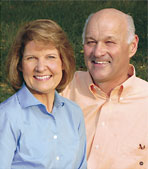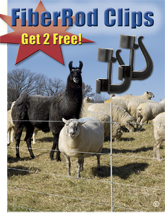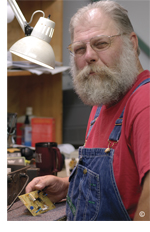Message from the Owner
A report from:The World Sheep & Wool CongressAt Queretaro, Mexico in late July. Occurs every 3 years. The 2004 Congress was in Quebec. The 2010 Congress will be in Sydney, Australia (in April). Consisted of 2 days of formal presentations followed by 4 days that included a day-long sheep nutrition seminar, visits to nearby sheep farms, a large sheep show (with carcass contests, shearing demonstrations, wool contests and breed contests), an extensive array of commercial exhibits and considerable "interpersonal interaction" (a good time!). The number of attendees (over 700) exceeded expectations. 80% were from Mexico-attesting to the keen interest in expanding Mexico's lamb production. Attendees also came from Canada, Australia, New Zealand, the USA, Spain, South Africa and S. America. The sheep industry of Mexico has been changing rapidly over the past 15 years from fine-wool breeds to meat breeds. The economic forces behind this change have been:
Memorable Presentations Included:
A Few Personal Notes:
by Stan Potratz Special Price from Premier!
FREE FiberRod ClipsWhen You Buy FiberRod Posts3/8" SmoothCote FiberRods (white)With every white FiberRod post (see link above) you buy, receive two SnapOn FiberRod Clip II's (link below) for free. The gray SmoothCote FiberRods are not included in this offer. SnapOn FiberRod Clip IIFor 3/8" FiberRod posts. Holds 1/4" rope, braid, twine, 1/2" tape and MaxiShock securely. Easy to apply. Fits both Premier's white and gray fiberglass rods. Clip is black. See our full line of conductors. To Order: Website: - Use Code News 26IT Offer good through September 30, 2007. Premier VIPFeeding Lambsby Susan Schoenian, University of Maryland There are many ways to feed lambs. One way is not better than the other. The appropriate feeding program is usually dictated by geographic location, production system, marketing options, and cost and availability of feed. Lambs born in the winter are often creep-fed and finished on high concentrate feeds, while lambs born later in the season are often placed on pasture with their dams. Feeding programs can utilize both pasture and grain. For the first several weeks of life, all a lamb needs for nourishment is its mother's milk. Lambs will start to nibble on solid food soon after birth. A ewe's milk production peaks between 3 and 4 weeks of lactation. By the time lambs are 4 to 6 weeks old, they may be obtaining as much as 50 percent of their nutrient intake from sources other than their mother's milk. Creep FeedingCreep feeding is a means of supplying extra nutrition, usually grain, to nursing lambs. It is especially beneficial for lambs managed in intensive production systems in which early weaning is practiced. Creep feeding is advantageous for flocks which have a lot of multiple births or in flocks where milk production is a limiting factor. It is more efficient to feed the lamb directly than to feed the ewes for milk production. Creep feeding is usually of less value for lambs that will be developed on pasture in the spring and summer. Creep feeding may not be cost-effective in all production systems. Lambs should be started on creep feed between 1 and 2 weeks of age, though they will not eat significant amounts of feed until they are three to four weeks old. Providing early access to creep feed gets lambs in the habit of eating dry feed and helps stimulate development of their rumens. It helps with early weaning. Lambs gain access to creep feed through a "creep," which is simply an opening in the fence or gate that is large enough for the lambs to get through, but too small for the ewes to enter. It is best that creep gates have multiple openings so the lambs do not think they are trapped. Ideally, the lambs should have access to the creep area from multiple sides. A small used tire can also be used as an inexpensive creep gate. Feeders used in the creep area should be designed so that lambs cannot stand or play in them. Two inches of feeder space per lamb is recommended. The creep area should be placed in a high traffic area where lambs will naturally find their way to it. A light in the creep area will help to attract lambs. A sunny spot in the barn is an ideal place to place the creep. In addition to providing creep feed, the creep area is a place for lambs to loiter and sleep. It should be kept dry and well-bedded. Two square feet of space per lamb is recommended for the creep area. Water should be available in the creep area, as well as high quality hay. Creep feeders can also be set up on pasture. The creep ration does not need to be complex or expensive. At a young age lambs prefer feeds that are finely ground and have a small particle size. Feeds that have high palatability for lambs include soybean meal, ground corn, and alfalfa hay. Some producers start lambs out on soybean meal. It is expensive, but the lambs do not eat much at an early age. Crumbled or textured rations are consumed better than pelleted creep feeds. The feed should be fresh and dry and should never be allowed to run out. Because the growth of young lambs is mostly lean muscle (protein) rather than fat, protein supply is critical. The creep ration should contain 18 to 20 percent crude protein. The protein in creep feed should be all natural; urea should not be fed to young lambs. As lambs get older, they prefer coarser diets and whole grains. Older lambs deposit more fat, thus their requirement for protein diminishes. The creep feed should contain a 2:1 calcium to phosphorus ratio to prevent urinary calculi (kidney stones) in male lambs. Inclusion of 1% feed grade limestone will also help to prevent urinary calculi. The creep feed should contain a coccidiostat to prevent coccidiosis. Deccox� (decoquinate) and Bovatec� (lasalocid) are both FDA-approved as coccidiostats for lambs. Rumensin� (monensin) is another coccidiostat, but it is not FDA-approved for lambs. Lambs should be vaccinated with Clostridium perfringins C & D to prevent overeating disease prior to weaning. Feeding Lambs From Weaning to MarketFeed Lot Finishing of LambsCreep-fed lambs are commonly weaned early (< 90 days) and placed on feed lot diets for finishing. Pasture-reared lambs must be brought gradually from a high roughage-low concentrate diet to a high concentrate-low roughage diet. This transition should take place over several weeks. When finishing lambs on high grain diets, acidiosis, enterotoxemia & urinary calculi can be potential problems. Acidosis can be prevented by including at least 10% roughage in the diet, by feeding a rumen buffer (e.g. sodium bicarbonate) and by avoiding sudden changes in the type or amount of ration fed. Urinary calculi can be prevented by providing a Ca:P ratio of at last 2:1, having a salt/mineral mix available free choice, and by feeding an urine acidifier like ammonium chloride. Getting lambs to drink plenty of water will also help to prevent urinary calculi. Corn and soybean meal commonly form the basis of these feed lot diets. However, other grains and protein sources can replace all or part of the corn and soybean meal in the diet, depending upon availability and cost. The energy value of barley and grain sorghum (milo) relative to corn is 90 percent. Both can replace 100 percent of the corn in the diet. Due to its higher fiber content, oats have only 80 percent of the energy value of corn. Wheat is equal to corn, but should not replace more than 50 percent of the corn or barley in the diet. Alternative sources of protein include cottonseed meal and peanut meal. Urea (the end product of nitrogen metabolism) has a crude protein equivalent of 281 percent and can supply up to one-third of the nitrogen in the diet (of older lambs). To determine the pounds of nitrogen in the diet, you multiply the total pounds of crude protein in the diet by 16 percent. The decision to use other feeds should be based on their availability and cost relative to corn and soybean meal. To determine if other feeds are a better value than corn and/or soybean meal, comparisons must be based on the cost per unit of nutrient (protein and energy). Differences in weight and nutrient content need to be factored into these calculations. Pasture Finishing of LambsThough pasture-fed lambs will usually not grow as fast as lambs fed concentrate diets, pasture rearing is often more economical. It is a more natural feed and environment for lambs. There seems to be a growing consumer demand for grass-fed animal products, due to the perceived health benefits. Grass-fed meat and milk tends to be lower in fat and higher in conjegated linoleic acid (CLA), vitamin E, omega-3 fatty acids, beta-carotene, and vitamin E than the meat and milk from grain-fed livestock. Regardless of diet, lamb is one of the best sources of CLA. Excellent pasture and grazing management is required to finish lambs on pasture. Lamb growth rate can vary greatly, depending upon the type and quality of pasture being grazed. As pasture quality declines, lamb gains decline. Rotational grazing systems which result in lambs consuming plants in a vegetative state, when they are the most nutritious and palatable, will produce the best pasture gains. Pastures containing legumes usually produce higher gains than those containing grass alone. The inclusion of warm season grasses into the pasture system may improve summer gains, as cool season grasses don't grow much during the summer months. Legumes will also improve summer growth of pastures. Lambs grazing "novel endophyte" (MaxQ) or non-toxic endophyte strains of tall fescue will gain better than those grazing infected fescue varieties. The initial grazing trials with MaxQ tall fescue were done with lambs. Lambs grazing Max Q or endophyte-free tall fescue gained 0.37 lbs. per day vs. lambs grazing endophyte-infected fall fescue, which gained only 0.22 lbs. per day. Over a typical May to September grazing season, lambs will gain about one-third of a pound per day on traditional cool season pastures (Pennsylvania, West Virginia, and Maryland data). Internal ParasitesInternal parasites (gastro-intestinal worms) can have a significant effect on the health and performance of grazing lambs. Traditional rotational and intensive grazing systems could exacerbate internal parasite problems, if pasture rest periods are not sufficient. In the past, it was advocated that grazing lambs be dewormed every three to four weeks during the grazing season. This practice has contributed to the widespread emergence of drug-resistance worms, making parasite control with anthelmintics more difficult and costly. Effective internal parasite control requires an integrated approach that combines appropriate pasture and animal management strategies with selective and/or targeted use of anthelmintics. Some forages have anthelmintic-like activity (e.g. sericea lespedeza, birdsfoot trefoil, and chicory) and can be incorporated into a pasture and grazing program. While coccidiosis is generally considered to be more of a problem with confined lambs, outbreaks can occur on pasture, especially with intensive grazing programs, where more lambs are concentrated on a smaller land area. In fact, any place where livestock congregate can be a potential source of infection: laneways, sheltering areas, watering areas, feeding areas. A coccidiostat (Bovatec® or Deccox®) in the mineral mix will help to prevent outbreaks of coccidiosis. Click here to view the complete article. Premier TipFence & Energizer Trouble ShootingDo The Following Checks First…
Premier Employee Spotlight
Carroll HansenThe August employee of the month is Carroll Hansen of Wayland, IA. Having worked at Premier for over 11 years in our repair department, Carroll says, "what he likes best is the diversity of the job. Every project and repair holds new challenges and solutions while at the same time helping a customer get through a problem." What he likes best about Premier is "being with a company that is constantly exploring and testing new products, finding solutions to old problems and focusing to stay on the cutting edge." Carroll has farmed all of his life in both California and Iowa. He grew up in northern California on a diversified irrigated row crop and livestock farm. While Carroll was in college the farm switched over to growing almonds and when he returned he spent 20 years perfecting the art of tending to almond trees. Wanting to return back to where his family was from, Carroll came to Iowa in 1994 to farm. He raised up to a 1000 fat hogs per year but now has semi-retired and raises 500 hogs a year. He and his wife Terri have been married for 30 years, have 3 children and 3 grandchildren. He enjoys hunting, fishing, restoring his old Massey Harris 44 tractor and doing maintenance around his farm. He is a member of the American Legion, the Veterans of Foreign Wars and the Farm Bureau. Carroll is very detailed and likes his tools in all of their appropriate places. Carroll can fix just about anything. RecipeGreek Lamb BurgersIngredients: 3 tomatoes/raw, peeled & cut into wedges Combine tomatoes & cucumbers in a salad bowl. Combine next 4 ingredients and salt and pepper to taste in a jar with a tight-fitting lid. Shake vigorously. Pour dressing over vegetables and toss. Cover and set aside. Turn on broiler. Combine lamb and next 3 ingredients in a mixing bowl. Gently form into 1 inch thick patties. Season with salt and pepper to taste. Broil burgers 4-5 minutes per side or until lamb is slightly pink inside. Serve burgers in pita bread pockets with tomato and cucumber mixture. Top with a dollop of yogurt. |




